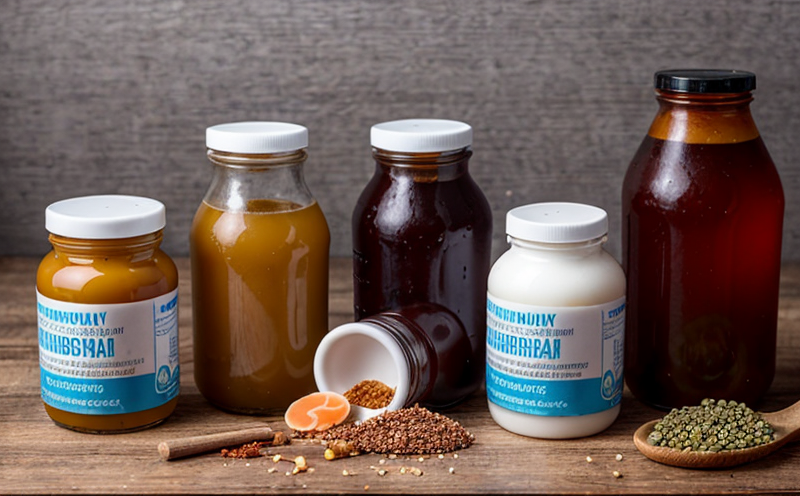AOAC 2018.01 Viable Probiotic Count Verification in Supplements
The AOAC International standard method AOAC 2018.01 is a critical tool for ensuring the quality and safety of probiotic supplements. This method provides precise, quantitative verification of viable probiotics in dietary supplements, which are increasingly popular due to their perceived health benefits. The standard plays an essential role in confirming that products meet regulatory requirements and label claims.
The AOAC 2018.01 methodology involves a series of steps designed to ensure the accurate enumeration of live cells within a probiotic product matrix. The process begins with sample preparation, which includes homogenization followed by serial dilution. This ensures that any viable microorganisms present are distributed uniformly throughout the sample. Next, the samples are inoculated onto appropriate growth media such as MRS (De Man Rogosa Sharpe) agar for lactic acid bacteria.
The growth of these organisms is then monitored over time, allowing for counting based on colony-forming units (CFUs). This method ensures that only viable cells contribute to the final count, providing a reliable indicator of product efficacy. The standard specifies strict conditions including temperature control during incubation and appropriate media types to optimize growth rates.
Compliance with this test is not only important for manufacturers but also crucial for regulatory bodies like the FDA who require such verification before allowing products onto the market. For consumers, accurate enumeration allows them to trust that they are receiving what was advertised on the label – a specific number of viable probiotics per serving.
Using AOAC 2018.01 helps prevent issues related to shelf life stability and ensures product consistency across batches. It supports both quality control measures at production facilities as well as post-market surveillance activities by regulatory authorities. By adhering to this rigorous testing protocol, manufacturers can maintain high standards of integrity and transparency which are vital in today’s competitive supplement industry.
The application of AOAC 2018.01 is particularly relevant given the growing number of dietary supplements containing probiotics. As more people turn towards natural remedies for health maintenance or treatment purposes, accurate testing becomes even more important to ensure these products deliver on their promises effectively and safely.
- Sample preparation: Homogenization followed by serial dilution
- Inoculation onto MRS agar plates
- Incubation at 37°C for up to 48 hours
- CFU enumeration based on visible colonies
By leveraging AOAC 2018.01, labs can provide reliable results that contribute significantly to the overall integrity of probiotic supplements in the marketplace.
Why It Matters
The importance of verifying viable probiotic counts cannot be overstated. For manufacturers, this process ensures compliance with regulatory requirements and helps maintain consumer trust by delivering on product claims. Inaccurate labeling can lead to legal repercussions and damage reputation; therefore, accurate testing is paramount.
From a public health perspective, ensuring that dietary supplements contain the correct number of viable probiotics supports overall wellness initiatives. Consumers rely on these products for digestive support or immune system boosting functions among others. When counts are verified correctly using standards like AOAC 2018.01, they can rest assured knowing their purchases align with advertised specifications.
Regulatory bodies also benefit from this type of rigorous testing as it aids in monitoring compliance and identifying potential safety concerns early on. This helps protect both manufacturers and consumers alike by fostering an environment where only high-quality products enter the market.
In summary, verifying viable probiotic counts through methods such as AOAC 2018.01 serves multiple purposes including regulatory compliance, consumer trust, public health initiatives, and regulatory oversight. It is a vital step in maintaining quality control throughout all stages of product development and distribution.
Benefits
The benefits of using AOAC 2018.01 for verifying viable probiotic counts are multifaceted:
- Regulatory Compliance: Ensures products meet stringent regulatory standards set by organizations like the FDA.
- Consumer Trust: Builds confidence among consumers who rely on accurate labeling and product efficacy.
- Quality Control: Provides assurance at every stage of production, from raw materials to final packaging.
- Safety Monitoring: Helps identify potential issues early through ongoing quality checks and audits.
- Competitive Edge: Differentiates brands that prioritize accuracy and reliability in their products.
- Market Integrity: Contributes to maintaining the overall integrity of dietary supplement markets globally.
Incorporating AOAC 2018.01 into your quality assurance processes can help you stay ahead in a competitive market while providing safe and effective products for consumers.





